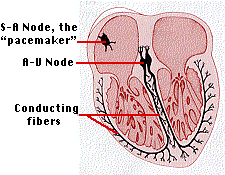| Index to this page |
During rest, the heart beats about 70 times a minute in the adult male, while pumping about 5 liters of blood.
| Link to anatomy of — and path of blood through — the heart. |

The stimulus that maintains this rhythm is self-contained. Embedded in the wall of the right atrium is a mass of specialized heart tissue called the sino-atrial (S-A) node. The S-A node is also called the pacemaker because it establishes the basic frequency at which the heart beats.
The interior of the fibers of heart muscle, like all cells, is negatively charged with respect to the exterior. In the cells of the pacemaker, this charge breaks down spontaneously about 70 times each minute. This, in turn, initiates a similar discharge of the nearby muscle fibers of the atrium. A tiny wave of current sweeps over the atria, causing them to contract.
| Link to the properties of heart muscle |
When this current reaches the region of insulating connective tissue between the atria and the ventricles, it is picked up by the A-V node (atrio-ventricular node). This leads to a system of branching fibers that carries the current to all parts of the ventricles.
The contraction of the heart in response to this electrical activity creates systole.
A period of recovery follows called diastole.The ventricles can maintain a beat even without a functioning A-V node, although the beat is slower. There is, however, a danger that impulses arising in the ventricles may become disorganized and random. If this happens, they begin to twitch spasmodically, a condition called ventricular fibrillation. Blood flow ceases and unless the heart rhythm is restarted, death follows swiftly. In fact, ventricular fibrillation is the immediate cause of as much as 25% of all deaths.
Hospital emergency rooms, ambulances, commercial air craft and many other public places are now equipped with defibrillators which, by giving the heart a jolt of direct current, may restore its natural rhythm and save the victim's life.
It increases the rate and strength of the heartbeat and thus increase the flow of blood. Its activation usually arises from some stress such as fear or violent exertion. The heartbeat may increase to 180 beats per minute. The strength of contraction increases as well so the amount of blood pumped may increase to as much as 25–30 liters/minute.
| The 24 Feb 2000 issue of the New England Journal of Medicine reports on a family some of whose members have inherited a mutant gene for the transporter that is responsible for reuptake of noradrenaline back into the neuron that released it. Those with the mutation are prone to bouts of rapid heartbeat and fainting when they suddenly stand up. |
(Distention of the wall of the right atrium also triggers the release of atrial natriuretic peptide (ANP) which initiates a set of responses leading to a lowering of blood pressure.)
| Link to discussion. |
Pressure receptors in the aorta and carotid arteries send impulses to the medulla which relays these — by way of the vagus nerves — to the heart. Heartbeat and blood pressure diminish.
| Link to discussion of the sympathetic and parasympathetic branches of the autonomic nervous system. |
| Link to anatomy of and path of blood through the heart. |
| Welcome&Next Search |